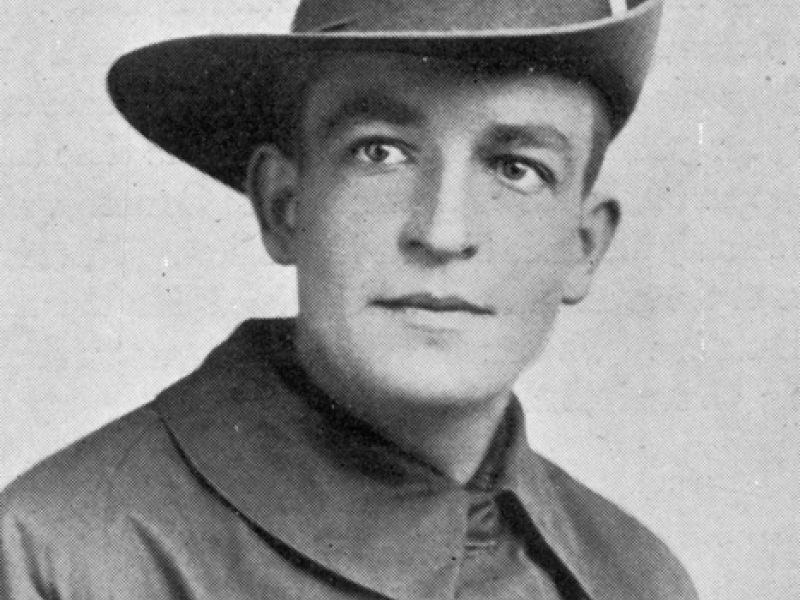Leonard Say
Leonard Say was born on the 17th August 1891 at the village of South Petherton, in Somerset, England. He was one of eight children of the Reverend George Say and his wife, Elizabeth (née Welchman). At the age of ten, his family moved four kilometres north to the village of Kingsbury Episcopi, Somerset.
On the 6th of April 1911, Leonard, and his older brother Douglas, boarded the SS Runic, a 12482 tonne ship of the West Star Line, bound for Melbourne, Australia. Initially, the two brothers had thought about immigrating to America, however their father suggested that Australia might be a better choice. He arrived in Victoria with certificates equal to the Australian First Class Certificate of Education and became a temporary teacher, being placed in charge of Ryton Primary School in Gippsland. In 1912 he acted in a similar capacity at Buffalo before becoming a permanent head teacher at Thougla. Records indicate that he “was a good teacher, bright and vigorous, interested in his work, and showing taste and care with regard to the school surroundings''.
Leonard enlisted on the 31st of August 1914, four weeks after war was declared. He was given the Regimental Number 506 and attached to D Company of the 3rd Battalion, 1st AIF. Almost two months later, on the 19th of October, the 3rd Battalion embarked on HMTS A14 Euripides at Fort Macquarie. They later joined other troopships from New Zealand, Melbourne and Albany, forming the first of two convoys that would convey Australian and New Zealand troops overseas.
On the 3rd of December the battalion arrived at Alexandria, disembarking the following day. On the 5th of December they arrived at Mena Camp, Egypt. The following months would see Leonard involved in many training exercises, along with short stints of leave to enjoy the local sights, sounds and smells.
On the 3rd of April, the 3rd Battalion embarked on HMTS A10 Derfflinger, arriving at Lemnos five days later. Much has been written about the Gallipoli Campaign and Leonard was involved in it, from the landing on the 25th of April to the withdrawal on the 29th of December. During that time he was reported as missing in action on the 29th of April and wounded in action on the 10th of July. On that day the Turks exploded a mine quite close to their own trenches and although it did not damage any of the Australian tunnels and trenches, casualties included one killed and five wounded, one of whom was Leonard.
After surviving Gallipoli and spending some time back in Egypt at Tel-el-kebir, the 3rd Battalion disembarked at Marseilles in southern France in late March of 1916. Other than training exercises, stints in the front and reserve lines, and promotion to Sergeant, Leonard had two separate stays in hospital, one suffering from bronchitis, the other from laryngitis. After returning from his latest stay in hospital he was transferred to the 1st Machine Gun Company. He also had two longer periods of leave, spending one week in Paris in September 1917 and two weeks in England during the last two weeks of October.
In early October, the 1st Machine Gun Company was involved in action in the Chateau Segard area. It was during this action that Sergeant Leonard Say was awarded the Military Medal. The citation stated:
“During the attack on the enemy positions East of Ypres on the morning of the 4th Oct. Sgt. SAY was with a section of machine guns, his C.C. and the other Sgt. being casualties thus leaving him in charge of the section in the early stage of the attack. He at once took charge and by good handling got his guns into position and reported in writing to Coy. H.Qrs. This N.C.O. by his personal bravery and cheerfulness, greatly encouraged his men under very trying circumstances. He remained in charge of the section until relieved on the night of 5th Oct.”
The 1st Machine Gun Company’s war diary for the 7th of November 1917 reads;
“Situation quiet during the night.
Intermittent shelling of D27A.1.4 during the day by enemy heavy artillery.
One of our M.G. was blown out at D18. A15.90. Casualties 1 killed 1 wounded.
Inter company relief took place during the night of the 7th and 8th. A + B sections relieving C and D.”
After having come through over three years of war, Leonard was killed the night his section was to be relieved.
Leonard Say has no known grave. He is remembered on the Australian War Memorial Roll of Honour, the Menin Gate Memorial, (Commonwealth Memorial to the Missing of the Ypres Salient), the Roll of Honour at St Martins, Kingsbury Episcopi, Somerset, England, and the Corryong War Memorial. For his service during the First World War, he was awarded the Military Medal, the 1914-1915 Star, the British War Medal and the Victory Medal.

 Stephen Learmonth
Stephen Learmonth